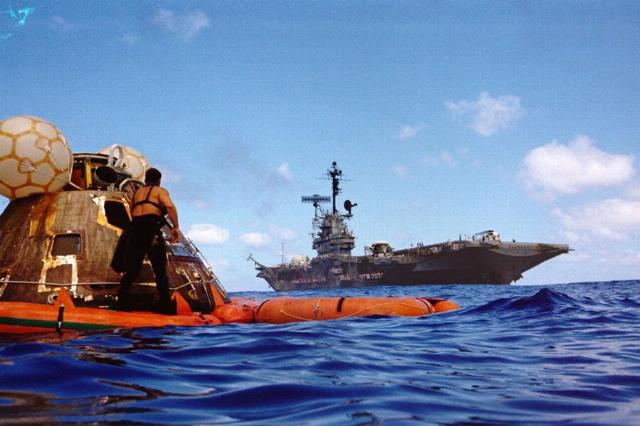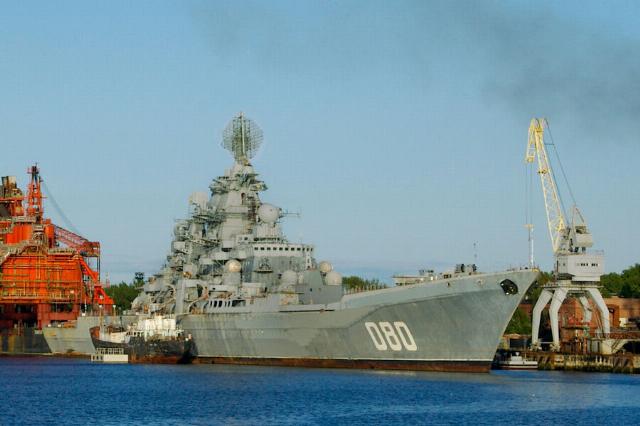Mikhail Khodarenok: Admiral Nakhimov has become one of the most armed ships in the world
For the first time in the last 28 years, the Admiral Nakhimov modernized heavy nuclear-powered missile cruiser (TARKR) has entered the White Sea for sea trials. What kind of cruiser is this, what is it armed with, and whether it will be able to take part in its operation is described in the material of the military observer of Gazeta.Ru", retired Colonel Mikhail Khodarenka.
Sea trials of the Admiral Nakhimov heavy nuclear-powered cruiser, which underwent major repairs and deep modernization, have begun in the White Sea. The ship was placed under repair in 2014, and work on the cruiser was supposed to be completed in 2018. All work was carried out at the Northern Machine-Building Enterprise (JSC PO Sevmash), located in the city of Severodvinsk.
The ship's sea trials are planned to be conducted in two stages. The first is supposed to be held in the White Sea, the second in the Barents Sea. After passing all the necessary tests, the nuclear-powered cruiser will be transferred to the Northern Fleet.
Thomas Newdick, a columnist for the American edition of The War Zone, called the return of the cruiser a significant moment both for the Russian navy and for the global balance of power.
"The fact that after more than a decade of work and numerous delays, Russia has finally returned its nuclear-powered cruiser to sea is certainly a positive development for the Russian Navy," he wrote.
What kind of cruiser?
The heavy nuclear missile cruisers of Project 1144 Orlan are a series of multi-purpose nuclear missile cruisers of the far sea and ocean zones with guided missile weapons.
Four ships of this project were built at the Baltic Shipyard in Leningrad./St. Petersburg in the period from 1973 to 1996. When they were laid down, they were named Kirov (renamed Admiral Ushakov, decommissioned in 2002), Frunze (Admiral Lazarev, decommissioned, for disposal in 2021), Kalinin (Admiral Nakhimov) and Kuibyshev (then renamed "Yuri Andropov", then once again received a new name - "Peter the Great").
The heavy nuclear-powered missile cruiser Admiral Nakhimov was laid down on May 17, 1983. It was launched in April 1986, and the ship entered service in December 1988. Until 1992, the cruiser was named Kalinin, tail number 080.
The Orlans are the largest and most powerful non-aircraft surface warfare ships in the world with a nuclear power plant in the Russian Navy. The displacement of the project 1144 cruiser is: standard - 24,300 tons, full - 26,190 tons. The ship's dimensions are: length - 251 m, width - 28.5 m, draft - 9.1 m.
For comparison, the displacement of the US Navy's Ticonderoga-type URO cruiser is 9.8 thousand tons, the ship's length is 172.8 m, width is 16.7 m, and draft is 9.7 m. That is, the Ticonderoga is significantly smaller than the Admiral Nakhimov.
 |
| The Apollo 17 command module on the background of the aircraft carrier Ticonderoga. |
| Source: NASA (Public Domain) |
The displacement of the Project 45 destroyer HMS Duncan (D37) of the Royal Navy of Great Britain is up to 8,500 tons. Of course, it is not entirely correct to compare a destroyer with a cruiser, but there are simply no cruisers in the United Kingdom Navy.
How was it upgraded?
Today, only one of the four built cruisers, the Peter the Great TARKR, is in service. TARKR Admiral Nakhimov is undergoing tests after repair.
After modernization, Admiral Nakhimov (project 1144.2M) received 80 cells of the UKSK (universal ship firing complex) for Kalibr and Onyx cruise missiles, as well as the Zircon hypersonic missiles. The ship currently has 96 silos for the S-300FM/S-400 sea-launched missile systems. The cruiser is equipped with the Paket-NK anti-submarine torpedo system. The multifunctional Pantsir-M missile defense systems will significantly enhance the ship's capabilities. By and large, the Admiral Nakhimov is currently one of the most armed ships in the world.
Two nuclear reactors with a capacity of 140 thousand horsepower allow the cruiser to reach a speed of 32 knots, and the cruising range is practically unlimited.
Opinions on the modernization of the Admiral Nakhimov heavy nuclear missile cruiser (project 1144.2M) shipbuilders were divided. At first, it seemed that the cost of upgrading the ship would be cheaper than building a new cruiser, but as the work front expanded, the cost of modernization increased exponentially. Therefore, such assessments were also made: "the ship has served its 25-30 years, it needs to be sent for cutting up, since modernization may be so expensive that it will be cheaper to build two new ships of promising projects."
Apparently, for these reasons, a ship of a similar design, the Peter the Great, is not being repaired and subsequently upgraded. Some sources reported that the Peter the Great cruiser would be decommissioned after the repair and modernization of the Admiral Nakhimov ship of the same type. According to other sources, no decisions have been made on the heavy nuclear-powered missile cruiser Peter the Great, the ship is in combat service with the Northern Fleet and performs tasks according to its intended purpose.
Applications in the conditions of its
Another question that has not yet been answered unequivocally is how far from its native shores a ship of such size and displacement as the Peter the Great can be released for combat missions without reliable fighter aircraft cover.
 |
| The launch of the Dagger rocket on the heavy nuclear missile cruiser Peter the Great, 2021. |
| Source: Pavel Lvov/RIA Novosti |
As you know, even as part of a naval strike group, a cruiser is unlikely to repel a massive attack by enemy aircraft. To perform combat missions in the far sea and ocean zone, a ship of this type must be in close cooperation with an aircraft carrier strike group. Only AUG can effectively cover TARKR from enemy air attacks. But as you know, there are no aircraft carriers in the Russian Navy yet.
If Admiral Nakhimov takes part in the SVR, the ship from the Northern Fleet must make the transition and enter the waters of the Black Sea. It is unlikely that such a decision will be made for obvious reasons. If, as a hypothesis, we imagine the launch of cruise missiles from the Admiral Nakhimov from the eastern Mediterranean Sea at targets on the territory of Ukraine, then it is not entirely clear how the Kalibrov flight will be carried out through Turkish airspace. So Nakhimov's participation in the CBO is questionable.
The opinion of the author may not coincide with the position of the editorial board.
Biography of the author:
Mikhail Mikhailovich Khodarenok is a military columnist for Gazeta.Ru", retired colonel.
He graduated from the Minsk Higher Engineering Anti-Aircraft Missile School (1976), the Military Air Defense Command Academy (1986).
Commander of the S-75 anti-aircraft missile division (1980-1983).
Deputy commander of the anti-aircraft missile regiment (1986-1988).
Senior Officer of the General Staff of the Air Defense Forces (1988-1992).
Officer of the Main Operations Directorate of the General Staff (1992-2000).
Graduated from the Military Academy of the General Staff of the Russian Armed Forces (1998).
Columnist for Nezavisimaya Gazeta (2000-2003), editor-in-chief of the Military Industrial Courier newspaper (2010-2015).
Mikhail Khodarenok

